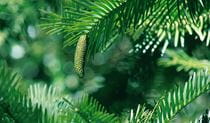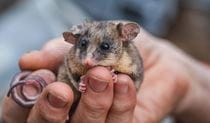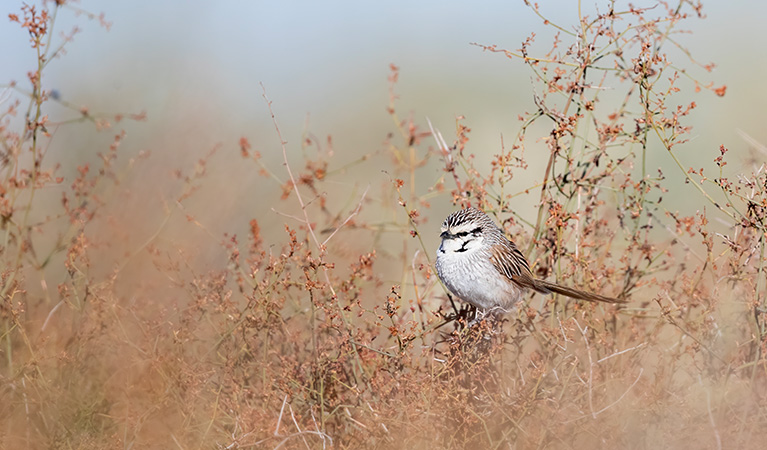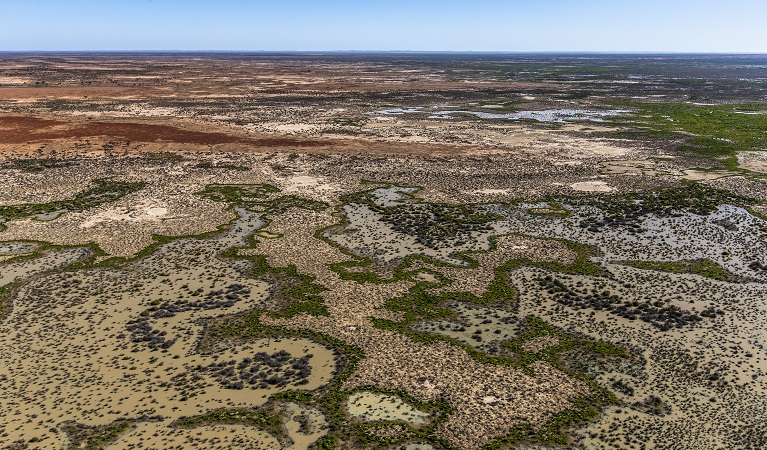Grey grasswren
The endangered grey grasswren (Bulloo subspecies) lives in the semi-arid floodplains of far western NSW and Queensland. Around 90 percent of this rare bird's NSW habitat is protected within Narriearra Caryapundy Swamp National Park.
Compared to their smaller, sociable fairy-wren relatives, the grasswren is an introvert. They shelter, roost, nest and feed almost entirely within dense, tall lignum shrubland or canegrass, though groups of 15 to 40 birds may forage together outside the breeding season, and during wetter years. Insect larvae make up the bulk of their diet, but mature insects and sometimes water snails and seeds are also on the menu.
Boom and bust - life in the outback
Along with other iconic outback birds, like the budgerigar and zebra finch, grey grasswrens experience ‘boom and bust’ cycles depending on seasonal availability of water. Favourable (La Nina) wet years transform their semi-arid floodplain habitat into thriving wetlands, offering grasswrens rich foraging. During these boom periods grasswrens find everything they need for feeding and nesting within a small home range. They may double their population in just a few years.
With the inevitable return of El Nino comes hot, dry times. Available seeds, insects and vegetation are dramatically reduced, forcing grasswrens to retreat into dense thickets of native lignum habitat. In these hard times populations decline significantly.
Secure refuge at last
In 2020, NSW National Parks and Wildlife Service (NPWS) acquired Narriearra Station in the state’s far north-west, to form Narriearra Caryapundy Swamp National Park.
This secured vast, semi-arid floodplains and ephemeral wetlands associated with the Bulloo River drainage system. The area makes up 90% of remaining grey grasswren (Bulloo subspecies) habitat in NSW.
For these birds, which are listed as an endangered species in NSW, the purchase ends a century of competition from cattle grazing. This is especially true for drought periods, when grasswrens take refuge in lignum shrubs, the same lignum hungry cattle seek out when little else in the landscape remains green.
If you're lucky, you may spot one of these rare grasswrens at Bartons tank bird hide, in the national park.
4 facts about grey grasswrens
Animal facts
- Common name
- Grey grasswren
- Scientific name
- Amytornis barbatus barbatus
- Conservation status in NSW
- Endangered
Looking ahead
With the conservation of nearly all remaining grey grasswren habitat in NSW, it’s hoped that these threatened native birds can flourish. Researchers estimate the current population at Narriearra includes up to 600 birds. It could reach a stable population of up to 2,000 birds as their key habitat improves.
Crucially, this population is thought to safeguard the long-term genetic viability of the Bulloo subspecies of grey grasswren.
The major threat now comes from climate changes and volatility. Longer, hotter and more frequent droughts will challenge even these outback survivors.
Extra protections
Several areas in Narriearra Caryapundy Swamp National Park have been declared an Asset of Intergenerational Significance (AIS), providing the strongest legal protections for the grey grasswren and its habitat, to ensure its survival for future generations.
You might also like
-

Assets of Intergenerational Significance (AIS)
Assets of Intergenerational Significance (AIS) are declared to bolster protections for an area with exceptional environmental or cultural values, like...
-

Protecting threatened species in parks
Around 84% of the approximately 900 threatened species in NSW are found in our national parks and reserves. Find out what we're doing to protect threa...
-

Saving our Species conservation program
Today, we're at risk of losing nearly 1000 of our state's native animals and plants. That's why the NSW Government established Saving our Species. It'...
-

Threatened Species Framework for zero extinctions
The NSW National Parks and Wildlife Service (NPWS) Threatened Species Framework outlines actions to meet our commitment of zero extinctions and restor...







